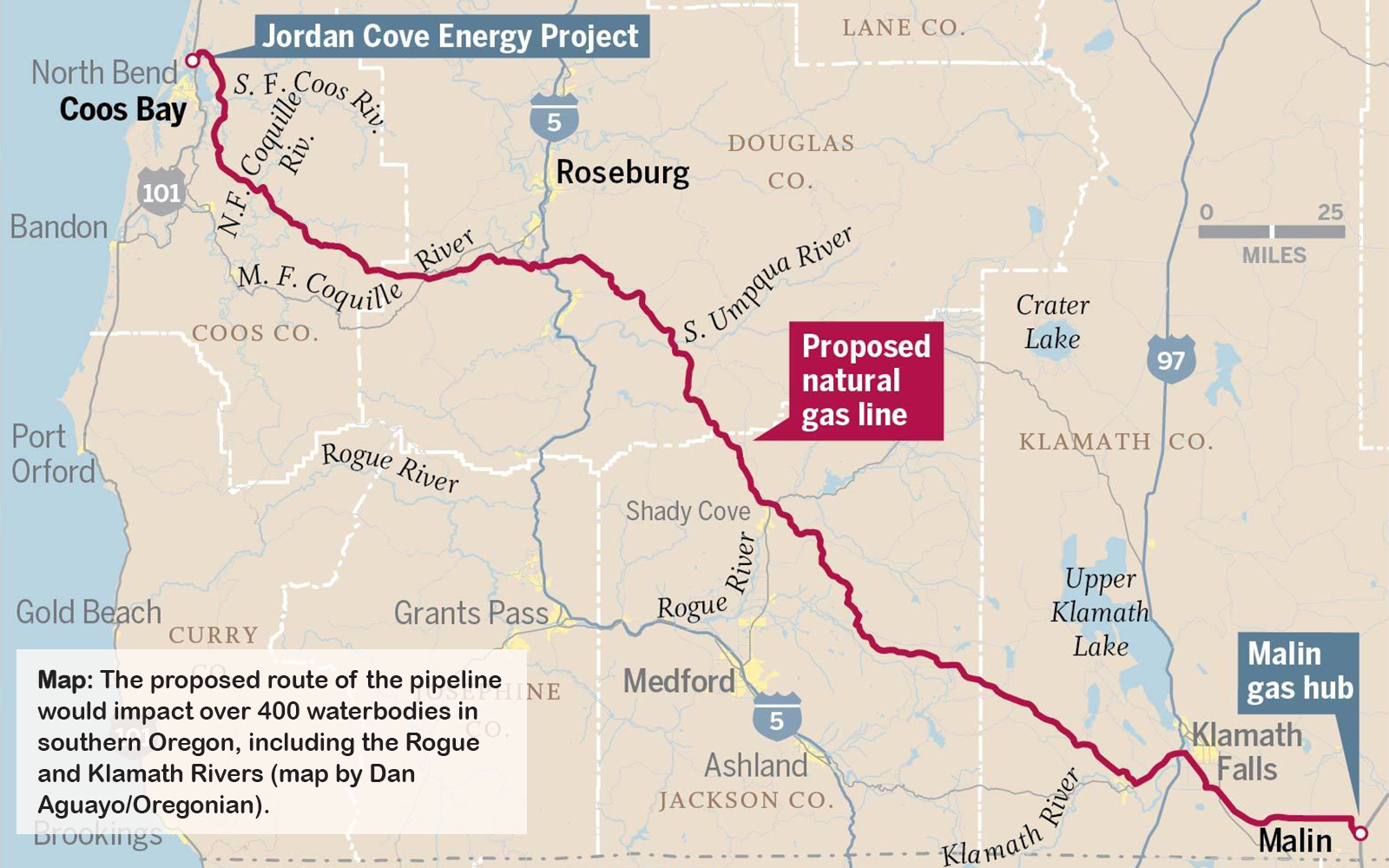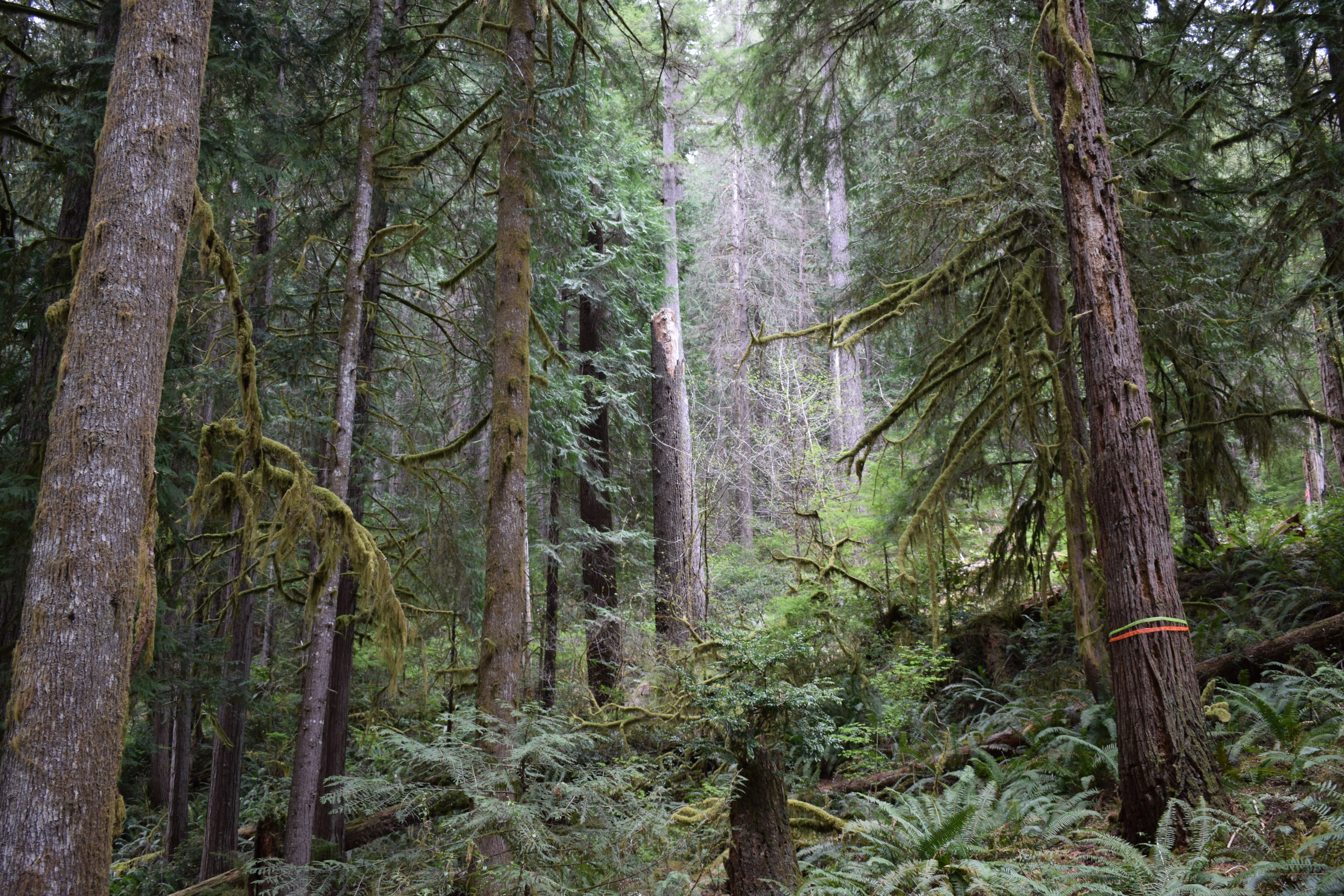
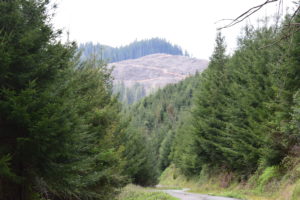
By Sam Krop, Cascadia Wildlands Grassroots Organizer
In the midst of the COVID-19 pandemic, we spent the weekend field checking a threatened area of old growth forest along the proposed Jordan Cove pipeline route out in the Oregon coast range between the towns of Remote and Sitkum, by Coquille.
As we drove along the coast range, we couldn’t help react at how nuked with clearcuts/tree plantations the area is. Both on private and BLM land, drainage after drainage of hillsides expose bare, eroding soil, murky streams and endless logging trucks hauling massive Douglas fir rounds to the mill. Most of the forest stands that we drove through were uniform — unhealthy and fire prone tree plantations that were protected as late successional reserve (LSR) by the NW forest plan in the 90s.
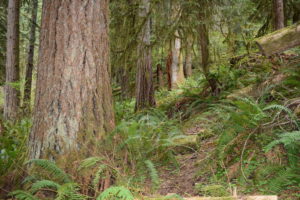
Thankfully, we had a tip about a potential spot of old-growth, spotted owl habitat somewhere deep off trail along the pipeline route. Skeptically, we drove through clearcut after tree plantation to get to the place we were told the old-growth could be. We parked at the end of a dusty logging road and looked into a dense and dark tree farm. Donning our coats and hats to protect from the thousands of delicate and flammable young tree branches in the plantation, we dove in.
In about a quarter mile of bushwhacking through the young tree farm, the forest began to change and open up as it sloped downwards towards a steep drainage where we could hear a stream noisily flowing below.
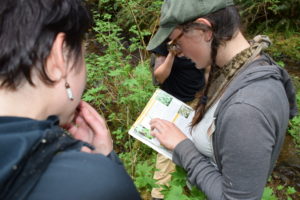
Emerging onto that waterway from the crowded and dark young forest was like the unraveling of a tension you don’t know you’re carrying. Soon we were greeted by massive old-growth trees and ancient snags, the guardians of a network of waterways at the base of the slope. We followed a trail across the first creek, which we later named ‘stinky creek’ after the many stink currants we identified growing all along it.
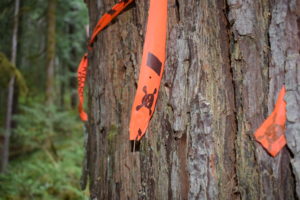
Looking down, we saw bear and coyote scat and even came across scattered piles of elk bones feeding the forest floor.
Looking up, we admired towering ancient and rotting snags with their myriad pock-marks from woodpeckers, sapsuckers and insects, the forest’s very own ecosystem engineers. These critical habitat snags were marked by the pipeline workers with bright orange flags that read “killer trees.” Laughing at the backwardness of reducing these life bearing snags to murderers, we noted that these would surely be the first cut if pipeline construction were to occur in this forest.
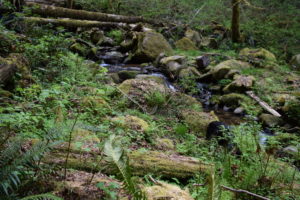
Walking through this forest, we simply couldn’t wrap our minds around how someone could see this place and think to destroy it.
We cut south from the pipeline route to follow the maincreek, lured in by the picturesque Cascadian river, which we later found out is home to threatened coastal coho salmon.
The river pools and bubbles up around rocks, flows under low hanging branches, splits and rejoins itself running steadily west through the forest.
Just as we felt things couldn’t get more beautiful, we stumbled upon a waterfall—a perfect smooth buttslide branching from the main stream, fed from some unseen tributary originating deep in the forest north of the river.
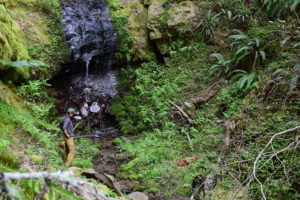 When we scrambled to the top of that waterfall, low and behold, we found another, even bigger waterfall with a little swimming pool at the base. In shock, we realized that this double waterfall is just a couple hundred feet south of the marked pipeline corridor.
When we scrambled to the top of that waterfall, low and behold, we found another, even bigger waterfall with a little swimming pool at the base. In shock, we realized that this double waterfall is just a couple hundred feet south of the marked pipeline corridor.
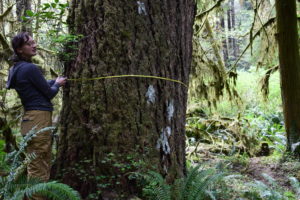
After centuries of survival through fire, wind and flood, the idea that a pipeline would destroy this pristine area is unthinkable.
What’s more, the presence of fire on the landscape is notable in the context of a highly explosive fracked gas pipeline. In a place where fires are recurrent and necessary for forest health, an inevitable fire coming into contact with a hazardous pipeline is terrifying even to consider. This situation is made more concerning by the highly flammable young timber plantations that surround this patch of pristine forest.
Settling down for the evening in our campsite just above the old-growth, we couldn’t help but wonder how someone could plan to construct a pipeline through the pristine forest we explored that day. It’s conceivable only when realizing that those behind this destructive project have likely never been to this place or seen any of the places the pipeline would impact for themselves. Pembina, the Canadian pipeline corporation backing the Jordan Cove LNG Project, are completely disconnected from the places and communities they plan to destroy. They don’t care about the old-growth or the threatened species that depend on it. They don’t care about the sacred places for indigenous cultures along the pipeline route. They don’t care about the landowners who would have their family properties used as right-of-way, against their will, for the construction of this fossil fuel transport project. Those responsible don’t know these places, and they really don’t care to.
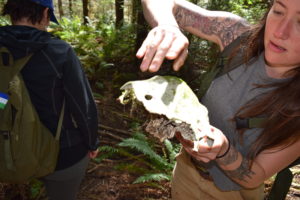
As we readied for bed that night, a dark shadow flew over our heads and let out an owl’s hoot. Moments later, that call was joined by another owl responding from the darkness just above our heads. We sat silently and listened, thrilled that we were visited by these feathered friends spying on our dwindling campfire. While we were convinced that it was a family of spotted owls communing with us on behalf of the forest – we later ID’d them as barred owls, which made sense given that we were camping in the young plantation just above the old grove. Still, we felt the forest was greeting us after our long day appreciating it, and it felt pretty amazing to make a couple bird friends during these isolating times in the COVID pandemic.
______________________________________________
Cascadia Wildlands is proud to be a part of a strong and growing coalition of conservation activists, landowners, tribes, and community members working to stop the Jordan Cove LNG pipeline. We are a part of this movement because we know intimately what is at stake if this project were to be built, and with that knowledge in mind, we won’t stop until the pipeline is stopped once and for all.

If you can help with this important effort, please take a moment and learn how to get involved. Last week, 29 members of US Congress sent a letter to FERC demanding a halt to construction and approvals during the coronavirus outbreak. None of Oregon’s Federal Representatives signed on to this letter to FERC.
Send an email to tell Oregon’s Congressional Delegation to urge FERC to halt approvals and construction during the coronavirus outbreak.

